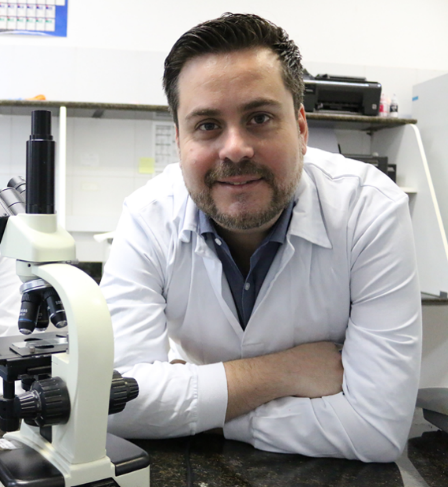
Professor Frank Crespilho’s research bridges the fields of physical-chemistry, bioelectrochemistry, and electrochemical-materials chemistry. Through his research Group, Professor Crespilho has trained more than 30 students, including undergraduate students, graduate students and postdoctoral researchers. His work focuses on in situ and operando spectroscopic-electrochemistry elucidation of the electron transfer mechanism involving redox enzyme, proteins, DNA and microorganism. He studies electron transfer reactions, and for this he has been developing electrodes based on carbon structures, 2D materials, mesoporous and non-conventional hybrid-magnetic materials. As far as fundamental science is concerned, he has made contributions on the field of protein immobilization processes on solid surfaces, bio-electrocatalysis and coupling analytical tools to resolve electron transfer mechanism in proteins. For instance recent achievements, he is the pioneer in couple Electrochemistry with Mass Spectrometry to observe the NADH reactions in Alcohol Dehydrogenases (Chemical Communications, 2017), and couple Electrochemistry with X-Ray Spectroscopy to details the 3-dimensional mechanism for O2 catalytic reduction reaction at the multicopper centers in Bilirubin Oxidase (Nature Communications, 2020). He developed a technique named Electrochemical Coupled Vibrational Spectromicroscopy (EVSM), patent number BR 10 2019 001293-5, which consist in a multiplex infrared spectroscopy imaging system for monitoring spatially resolved redox chemistry in inorganic and biological materials (Analytical Chemistry, 2018).
The technological implications of his research include the development of efficient biomimetic catalysts, biomimetic materials for application in the field of energy, more efficient biofuel cells, organic and organometallic batteries that mimic redox biological processes, development of materials applied to mimetic sensors and biosensors. For example, batteries containing organic and organometallic compounds that mimic cell respiration has been produced with the knowledge of quinone redox chemistry, redox enzymes and biomimetic molecules. With collaborators from Harvard University, he was able to show that it is possible to develop hydrogels and new molecules for sustainable and non-toxic batteries. Also, he developed an implantable glucose biosensor using biocompatible materials.
Professor Crespilho enjoys working on audacious projects with breakthrough approaches, as well as collaborating with several international scientists, including who’re at leading institutions around the world, such as Harvard University, Max Planck Institute, Caltech, MIT, NIMS, and others.
Professor Crespilho was born in the beautiful city of Jaú, located in the state of São Paulo, Brazil. He received his BS in 2002 and MS in Chemistry in 2004 from the São Paulo University. He received his Ph.D. in Physical Chemistry from the same institution in 2007 with Prof. Dr. Francisco C. Nart and Prof. O.N. Oliveira Jr. (co-supervisor), with one-year stay as Visiting Researcher (2005-2006) in the lab of Prof. Dr. C.M.A. Brett at University of Coimbra (Portugal). He was Post-Doctoral Researcher (2008) in the lab of Prof. Dr. V. Zucolotto (USP, Brazil) and Associate Professor of Chemistry at Federal University (UFABC), Brazil (2009-2012). He was Visiting Associate in Chemistry at California Institute of Technology, Caltech (EUA), in the Prof. Dr. J.K. Barton’s Group (2014-2015), and Visiting Professor at Max-Planck-Institute for Solid State Research, Stuttgart, Germany (2016), working at Prof. Dr. Klaus Kern Group with Dr. Kannan Balasubramanian (Senior Scientist). He was Visiting Professor at Harvard University at the lab of Prof. Michael Aziz (2018-2019). Since 2012, Crespilho is Professor of Physical-Chemistry at Chemistry Institute of São Carlos, and since 2019 he is fellow of the J. A. P. School of Engineering and Applied Sciences, Harvard University.
- 2019: KURT POLITZER TECHNOLOGY AWARD 2019 from Brazilian Chemistry Industry Association (Abiquim).
- 2019: YVONNE MASCARENHAS MEDAL from São Carlos City Hall.
- 2018: SAO CARLOS SCIENCE AND TECHNOLOGY AWARD from Sao Carlos City Hall.
- 2014: IQSC POSTGRADUATION AWARD 2013 – High impact publication in Physical Chemistry from University of São Paulo.
- 2013: THE QUIMICA NOVA AWARD FOR YOUNG AUTHORS from Brazilian Chemical Society (SBQ).
- 2013: IQSC POSTGRADUATION AWARD 2012 – High impact publication in Physical Chemistry from University of São Paulo.
- 2012: AFFILIATE MEMBER OF THE BRAZILIAN ACADEMY OF SCIENCES (2012-2016) from Brazilian Academy of Sciences.
- 2011: FELLOW PRODUCTIVITY (LEVEL 2) from CNPq, Brazil.
- 2009: THE ELECTROCHIMICA ACTA TRAVEL AWARD FOR YOUNG ELECTROCHEMISTS from Elsevier and International Society of Electrochemistry (ISE).
- 2007: METROHM AUTOLAB AWARD from Autolab Electrochemical Instruments and Scientific Committee of 16º SIBEE.
- 2004: HONORABLE MENTION, PAE–CAPES from São Carlos Institute of Chemistry, University of São Paulo.
- Deputy Coordinator, Institute of Advanced Studies at USP, Sao Carlos, 2019-current.
- Associate Professor, University of São Paulo, Brazil, 2017-current.
- Fellow of the J. A. P. School of Engineering and Applied Sciences, Harvard University, 2019-current.
- Visiting Professor, Harvard University, Cambridge, 2018-2019.
- Assistant Professor, University of São Paulo, Sao Carlos, 2012-2017.
- Visiting Professor, Max Planck Institute, Stuttgart, 2016-2016.
- Visiting Professor, California Institute of Technology (CALTECH), Pasadena, 2014-2015.
- Adjunct Professor, Federal University of ABC, Brazil, 2009-2012.
- Visiting Professor, Federal University of ABC, Brazil, 2008-2009.
- Post Doctorate, São Carlos Institute of Physics, 2007-2008.
- Visiting Researcher, University of Coimbra, Portugal, 2005-2006.
- Member of the following organizations: Brazilian Electrochemical Society (SBEE), Brazilian Chemical Society (SBQ), Brazilian Materials Research Society (B-MRS), Materials Research Society (MRS), Bioelectrochemical Society (BES), International Electrochemical Society (ISE) and American Chemical Society (ACS).
- Coordinator of the Bioelectrochemistry and Interfaces Laboratory at USP, São Carlos.
- Editorial board of ChemElectroChem Journal, Wiley-VCH.
- Editor, Chemistry field, Annals of the Brazilian Academy of Sciences (AABC).
- User Researcher at the Center for Nanoscale Systems (CNS) at Harvard University.
- User Researcher at the Brazilian Synchrotron Light Laboratory (CNPEM-LNLS).
